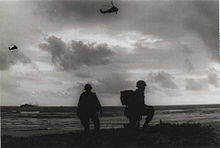Operation
On 12 January the Marines conducted a feint against Mộ Đức District approximately 20 km south of the operation area. [1] : 300–1
At 07:00 on 13 January the Marines landed on the peninsula meeting negligible resistance. Once ashore the Marines linked up with Task Force Cooksey and then pushed east forcing the VC towards the sea. While encounters with the VC were minimal, the Marines encountered extensive networks of mines, booby-traps and fortifications. On 19 January 2/26 Marines captured 56 Vietnamese of military age, under interrogation they were found to be members of the C-95th Sapper Company. The Marines evacuated numerous civilians for screening, eventually totaling some 11,900 people. [1] : 301
On 24 January 2/26 Marines returned to their amphibious assault ships. [1] : 301
Following the conclusion of the assault phase, Operation Russell Beach continued with Marine combined action teams, the 46th Infantry Regiment and the ARVN 6th Regiment operating to cleanse the peninsula of VC/People's Army of Vietnam forces. [1] : 303
The Battle of An Lão took place in the An Lão District of Bình Định Province, just over 300 miles north-east of Saigon between December 7–9, 1964. The battle was part of a larger 5th Military Region operation known as Campaign An Lão to capture An Lão valley, and use it as a corridor between their military bases in Quảng Ngãi Province and Bình Định Province.

The Battle of Ba Gia was a major battle that marked the beginning of the Viet Cong's (VC) Summer Offensive of 1965, during the early phases of the Vietnam War. The battle took place in Quảng Ngãi Province, South Vietnam, between May 28–31, 1965.

Operation Sure Win 202 was a 1964 Army of the Republic of Vietnam (ARVN) operation carried out with US support. ARVN commandos were transported by U.S. helicopters behind entrenched Viet Cong (VC) positions, attacking them with shoulder fired rockets and flame throwers. Sniper teams then tracked the fleeing rebels and engaged them.
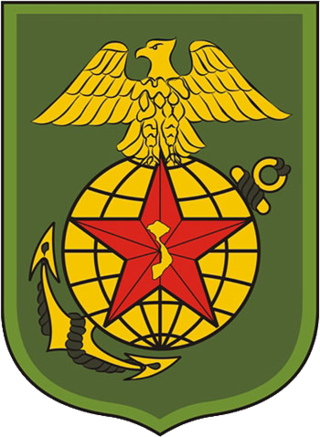
The Republic of Vietnam Marine Division was part of the armed forces of South Vietnam. It was established by Ngo Dinh Diem in 1954 when he was Prime Minister of the State of Vietnam, which became the Republic of Vietnam in 1955. The longest-serving commander was Lieutenant General Le Nguyen Khang. In 1969, the VNMC had a strength of 9,300, 15,000 by 1973, and 20,000 by 1975.

The Vietnamese Rangers (Vietnamese: Biệt Động Quân), commonly known as the ARVN Rangers or Vietnamese Ranger Corp (VNRC), were the light infantry of the Army of the Republic of Vietnam. Trained and assisted by American Special Forces and Ranger advisers, the Vietnamese Rangers infiltrated beyond enemy lines in search and destroy missions. Initially trained as a counter-insurgency light infantry force by removing the fourth company each of the existing infantry battalions, they later expanded into a swing force capable of conventional as well as counter-insurgency operations, and were relied on to retake captured regions. Later during Vietnamization the Civilian Irregular Defense Group program was transferred from MACV and integrated as Border Battalions responsible for manning remote outposts in the Central Highlands.

Phase Two of the Tet Offensive of 1968 was launched by the People's Army of Vietnam (PAVN) and Viet Cong (VC) against targets throughout South Vietnam, including Saigon from 29 April to 30 May 1968. The May Offensive was considered much bloodier than the initial phase of the Tet Offensive. U.S. casualties across South Vietnam were 2,169 killed for the entire month of May, making it the deadliest month of the entire Vietnam War for U.S. forces, while South Vietnamese losses were 2,054 killed. PAVN/VC losses exceeded 24,000 killed and over 2,000 captured. The May Offensive was a costly defeat for the PAVN/VC.

The 1st Division of the Army of the Republic of Vietnam (ARVN)—the army of the nation state of South Vietnam that existed from 1955 to 1975—was part of the I Corps that oversaw the northernmost region of South Vietnam, the centre of Vietnam.
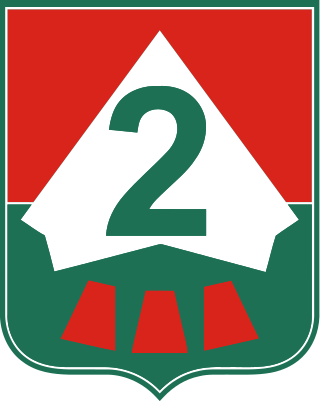
The 2nd Division was a division of the Army of the Republic of Vietnam (ARVN)—the army of the nation state of South Vietnam that existed from 1955 to 1975. It was part of I Corps that oversaw the northernmost region of South Vietnam.

The 2nd Marine Infantry Division, also known as Blue Dragon Division or more literally the Aqua (color) Dragon Division, is an infantry division of the Republic of Korea Marine Corps.
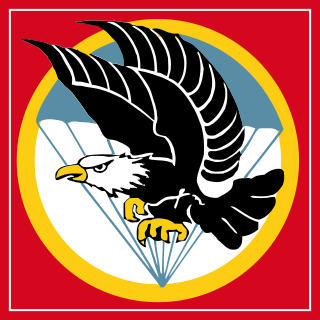
The Vietnamese Airborne Division or VNAD was one of the earliest components of the Republic of Vietnam Military Forces. The Vietnamese Airborne Division began as companies organized in 1948, prior to any agreement over armed forces in Vietnam. After the partition of Vietnam, it became a part of the Army of the Republic of Vietnam. This division had its distinct origins in French-trained paratrooper battalions, with predecessor battalions participating in major battles including Dien Bien Phu and retained distinct uniforms and regalia. With the formation of an independent republic, the colonial paratroopers were dissolved, however regalia and aesthetics alongside the nickname "Bawouans" would be retained.

The year 1968 saw major developments in the Vietnam War. The military operations started with an attack on a US base by the North Vietnamese People's Army of Vietnam (PAVN) and the Viet Cong (VC) on January 1, ending a truce declared by the Pope and agreed upon by all sides. At the end of January, the PAVN and VC launched the Tet Offensive.

The inauguration of Richard Nixon in January led to a reevaluation of the U.S. role in the war. U.S. forces peaked at 543,000 in April. U.S. military strategy remained relatively unchanged from the offensive strategy of 1968 until the Battle of Hamburger Hill in May which led to a change a more reactive approach. The U.S. and South Vietnam agreed on a policy of Vietnamization with South Vietnamese forces being expanded and equipped to take over more of the ground combat from the departing Americans which began to withdraw in late June without any reciprocal commitment by the North Vietnamese. The morale of U.S. ground forces began to fray with increasing racial tensions and the first instances of fragging and combat refusal. The antiwar movement in the U.S. continued to grow and public opinion turned increasingly antiwar when the Mỹ Lai massacre was revealed in November.
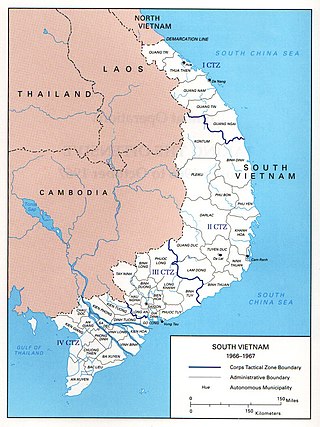
At the beginning of 1966, the number of U.S. military personnel in South Vietnam totaled 184,300. South Vietnamese military forces totaled 514,000 including the army (ARVN) and the Regional Force and Popular Force militias. The North Vietnamese People's Army of Vietnam (PAVN) numbered 400,000, most still in North Vietnam. 50,000 PAVN cadre and soldiers infiltrated South Vietnam during 1965. Group 559, charged with transporting supplies down the Ho Chi Minh Trail to supply PAVN troops in both South Vietnam and Laos, numbered 24,400 personnel. The U.S. estimated the number of Viet Cong (VC) and PAVN soldiers in South Vietnam at nearly 280,000 by June 1966, including part-time guerrillas. A pause in the bombing of North Vietnam by U.S. warplanes had been announced by President Johnson on 24 December and remained in effect.
The Ba Làng An Peninsula is a peninsula in Quảng Ngãi Province, Vietnam, northeast of Quảng Ngãi and 32 kilometres (20 mi) south of Chu Lai. The name was often mispronounced as "Ba Tang An" and known as Batangan during the Vietnam War, although Far Eastern Economic Review and other sources continue to refer to the "Ba Lang An peninsula".
The Battle for Quang Tri occurred in and around Quảng Trị City, the northernmost provincial capital of South Vietnam during the Tet Offensive when the Vietcong (VC) and People's Army of Vietnam (PAVN) attacked Army of the Republic of Vietnam (ARVN) and American forces across major cities and towns in South Vietnam in an attempt to force the Saigon government to collapse. This included several attacks across northern I Corps, most importantly at Huế, Da Nang and Quảng Trị City. After being put on the defensive in the city of Quảng Trị, the Allied forces regrouped and forced the PAVN/VC out of the town after a day of fighting.

The Hue–Da Nang Campaign was a series of military actions conducted by the People's Army of Vietnam (PAVN) against the Army of the Republic of Vietnam (ARVN) during the Vietnam War, also known in Vietnam as the American War. The campaign was centred on the cities of Huế and Da Nang, with secondary fronts in the provinces of Quảng Trị and Quảng Ngãi. The campaign began on March 5 and concluded on April 2, 1975.

Operation Piranha was a US Marine Corps operation during the Vietnam War that took place on the Batangan Peninsula from 7 to 10 September 1965.

Operation Double Eagle was a US Marine Corps and Army of the Republic of Vietnam (ARVN) operation that took place in southern Quảng Ngãi Province, lasting from 28 January to 17 February 1966, during the Vietnam War. The operation was mounted in conjunction with Operation Masher in northern Bình Định Province. The operation was inconclusive as the People's Army of Vietnam (PAVN) and the Vietcong (VC) had largely slipped away.
The War of the flags was a phase of fighting throughout South Vietnam lasting from 23 January to 3 February 1973 as the forces of North and South Vietnam each sought to maximize the territory under their control before the ceasefire in place agreed by the Paris Peace Accords came into effect on 27 January 1973. The fighting continued past the ceasefire date and into early February. South Vietnamese forces made greater territorial gains and inflicted significant losses on the North Vietnamese forces.

Operation Muscatine was a security operation conducted during the Vietnam War by the US Army in Quảng Ngãi Province, South Vietnam from 18 December 1967 to 10 June 1968. During this operation on 16 March 1968 the 1st Battalion, 20th Infantry Regiment and the 4th Battalion, 3rd Infantry Regiment carried out the My Lai Massacre.
